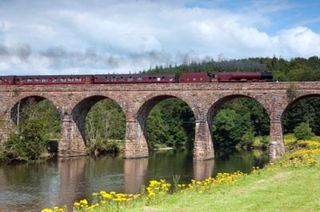Full steam ahead for trains
Train travel is enjoying a great renaissance, according to new figures


Fifty years after Richard Beeching's infamous Reshaping the British Railways report led to the axing of more than 5,000 miles of track, hundreds of branch lines and 2,363 stations, train travel is enjoying a renaissance. According to a recent document published by Network Rail, the Association of Train Operating Companies (ATOC) and rolling stock companies, passenger numbers have doubled from 761 million to 1.4 billion since John Major's government privatised the rail industry in 1993.
Now, several of the line closures of the 1960s are being reversed. The ‘varsity line' between Oxford and Cambridge and a 35-mile section of the Waverley route from Galashiels to Edinburgh are set to reopen. Routes near Birmingham and in the East Midlands and South Wales have been restored. The Settle-Carlisle railway (S&C), much loved for its views, Victorian architecture and stone viaducts, and which was reprieved after Dr Beeching recommended it for the chop, seems more popular than ever, as does the West Somerset Railway, now a heritage line.
‘This shows the folly of proposing to close major trunk routes such as the S&C and the Waverley,' reflects John McGoldrick, curator at the National Railway Museum. ‘These were far from being branch lines, although they did pass through sparsely populated areas. The S&C provides a great deal of capacity for heavy freight, is a useful diversionary route when the West Coast Main Line is out of action, and is hugely popular with leisure travellers.'
* Subscribe to Country Life and save; Get the Ipad edition
Dr Beeching's prime targets were branch lines ‘so lightly loaded as to have no chance of paying their way'. However, some of these thrive today as community railways, argues Neil Buxton of the Association of Com-munity Rail Partnerships. ‘Community Rail took up Beeching's challenge and showed that you could actually make them more viable by involving the people they served. Some, such as the Cambrian coast line (Machynlleth-Pwllheli) were put up for closure several times and turned down on the grounds of the hardship that would be caused for local people.'
Rail experts are keen to correct the folkloric impression of Dr Beeching as the big bad wolf, however. ‘He was only the public face of a heavily road-orientated government with a transport minister, Ernest Marples, who was, conveniently, the owner of a massive road-building company,' points out Mr Buxton. ‘Oil was cheap and the private car was in the ascendancy, so many of the lines were, quite rightly, ripe for closure, having outlived any usefulness they might have had.' Mr McGoldrick agrees, pointing to the growing deficit being racked up by British Railways. ‘The cuts were a logical extension of a policy that had been developing since the 1950s.'

In many ways, Dr Beeching merely reflected the car-centric spirit of the 1960s, but in 2009, an ATOC report not only recommended reopening 14 old lines, it even advocated bringing passenger services back on some ‘heritage' lines managed by steam enthusiasts. One of the most popular, the Bluebell Railway in Sussex, is celebrating the restoration of the line to its East Grinstead terminus, the first time it's been connected to the national network since 1963.
Sign up for the Country Life Newsletter
Exquisite houses, the beauty of Nature, and how to get the most from your life, straight to your inbox.
‘Dr Beeching lived at East Grinstead,' says Tony Drake of the Bluebell Railway museum, ‘and he opened a halt at Holywell, later closed. The Bluebell had been closed twice and partly reopened by the time he'd written his report.' Jack Watkins
* Follow Country Life magazine on Twitter
Country Life is unlike any other magazine: the only glossy weekly on the newsstand and the only magazine that has been guest-edited by HRH The King not once, but twice. It is a celebration of modern rural life and all its diverse joys and pleasures — that was first published in Queen Victoria's Diamond Jubilee year. Our eclectic mixture of witty and informative content — from the most up-to-date property news and commentary and a coveted glimpse inside some of the UK's best houses and gardens, to gardening, the arts and interior design, written by experts in their field — still cannot be found in print or online, anywhere else.
-
 A well-connected rural playground with 23 acres on the edge of the South Downs National Park
A well-connected rural playground with 23 acres on the edge of the South Downs National ParkOld House Farm is an impressive family home with a wealth of amenities that would inspire any rural passion.
By Arabella Youens Published
-
 The UK gets its first ‘European stork village’ — and it's in West Sussex
The UK gets its first ‘European stork village’ — and it's in West SussexAlthough the mortality rate among white storks can be up to 90%, the future looks rosy for breeding pairs in southern England.
By Rosie Paterson Published
